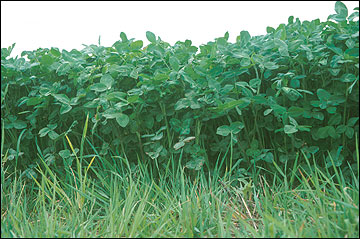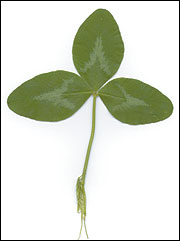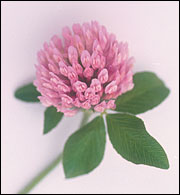Red clover (Trifolium pratense L.)
Legumes
Red clover is a short-lived, perennial legume grown on 7–10 million acres in Missouri. Although alfalfa has superior yield and quality under ideal conditions, red clover is much better adapted to the poorly drained, shallow or infertile soils frequently found on pasturelands. It is easier to establish than other legumes and works well in a mixture with cool-season grasses. It has problems dealing with prolonged drought and root diseases. However, it can be reseeded rather easily and inexpensively. In fact, many producers broadcast 3 to 6 lb/acre of seed annually to maintain stands.
 Red clover
Red clover
 Yield distribution of red clover in Missouri.
Yield distribution of red clover in Missouri.
- Origin: Asia Minor and southeastern Europe
- Adaptation to Missouri: Statewide
- Growth habit: Erect, short-lived perennial.
- Leaf: Palmately trifoliolate, pubescent with a pale, crescent-shaped mark on upper surface.
- Stems: Hollow, pubescent.
- Stipules: Fused to petiole.
- Flowers: Terminal on main and axillary stems, consists of many compound racemes with pink to purple florets, forming a dense head.
- Fertilization: No N needed if nodulated. Maintain 30 lb P/acre and 250 lb K/acre.
- Timing of production: 65 percent of annual production between April 1 and June 30.
- When to begin grazing: Often based on the height of the grass in the mixture. In pure stands, grazing should begin when red clover is in the early- to midbud stage.
- When to cut for hay: Early to midbloom
- Lowest cutting or grazing height: 3 or 4 inches
- Fall management: Avoid grazing below a 4-inch stubble height from Sept. 15 until the first hard killing frost.

